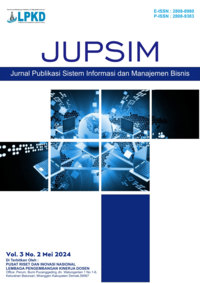Evaluasi Kinerja Sektor Pertanian dalam Kontribusinya terhadap Pendapatan Nasional dengan Pendekatan Metode Produksi
DOI:
https://doi.org/10.55606/jupsim.v4i2.4224Kata Kunci:
Agriculture, Income, ProductionAbstrak
The agricultural sector plays a crucial role in the Indonesian economy, contributing an average of 12.4-13.4% to national GDP in the last decade. This contribution does not only come from on-farm activities but also involves upstream-downstream value chains that can increase economic impacts by more than 20% if they include the processing industry. The research method used to assess the performance of the agricultural sector is descriptive and inferential analysis combined with a quantitative approach. Relevant secondary data sources are the Central Statistics Agency (BPS) and other official sources, including labor data, GDP data, and agricultural commodity production data. Based on the data analyzed, the contribution of the agricultural sector to Indonesia's Gross Domestic Product (GDP) has fluctuated. In 2022, the contribution of the agricultural sector was recorded at 12.40%, although there was a decrease compared to previous years. However, this sector is still able to absorb a significant workforce, with around 28% of the total national workforce involved in it. Evaluation of the performance of the agricultural sector shows that this sector is still an important pillar in the Indonesian economy, with a significant contribution to GDP, labor absorption, and foreign exchange through exports. Despite its fluctuating contribution to GDP and structural challenges such as reliance on conventional production methods, the agricultural sector is competitive in the international market. The plantation and fisheries subsectors are the main contributors to this sector, demonstrating Indonesia's great potential in leading export commodities and maritime resources.
Referensi
Annisa, R. D., & Riofita, H. (2024). Tantangan implementasi kebijakan moneter dan fiskal di negara-negara berpenghasilan rendah: Tinjauan literatur. Journal of Accounting Law Communication and Technology, 1(2), Juli 2024.
Astuti, R. Y., & Widodo, T. (2020). Strategi pengembangan UMKM di era digital. Jurnal Ekonomi dan Bisnis Indonesia, 5(2), 115–124.
Handayani, T., & Putra, S. (2023). Digitalisasi layanan publik di Indonesia: Peluang dan tantangan. Jurnal Teknologi dan Masyarakat, 6(3), 121–130.
Komala Putri, R., dkk. (2021). Observasi faktor pendorong produksi padi. Jurnal Riset Ilmu Ekonomi, 1(3).
Mulyani, S., & Kurniawan, B. (2021). Manajemen keuangan desa dalam perspektif transparansi dan akuntabilitas. Jurnal Ekonomi dan Keuangan Daerah, 13(1), 22–33.
Prasetyo, B., & Hidayat, T. (2021). Analisis efektivitas pelatihan kerja terhadap peningkatan kompetensi karyawan. Jurnal Manajemen Sumber Daya Manusia, 9(1), 45–52.
Riofita, H. (2017). Pengaruh motivasi finansial dan nonfinansial terhadap kinerja karyawan Badan Pelayanan Perizinan Terpadu Provinsi Riau. FKIP Journal UNS System.
Riofita, H. (2018). Analisis pelayanan prima dan kualitas pelayanan Badan Pelayanan Perizinan Terpadu Provinsi Riau. Jurnal Pendidikan Ekonomi, Manajemen dan Keuangan, 2(1), Mei 2018.
Riofita, H. (2024). Analisis kebijakan moneter terhadap inflasi di Indonesia. Jurnal Studi Multidisipliner, 8(6), Juni 2024.
Riofita, H. (2024). Peranan pengendalian peluang dan risiko yang dirasakan pada kesediaan merekomendasikan fintech syariah. Jurnal Ekonomi Indonesia, 13(2), 2024.
Rompas, J., dkk. (2015). Potensi sektor pertanian dan pengaruhnya terhadap penyerapan tenaga kerja di Kabupaten Minahasa Selatan. Jurnal Berkala Ilmiah Efisiensi, 15(4), 2015.
Sari, D. M., & Nugroho, H. (2022). Pengaruh gaya kepemimpinan transformasional terhadap kinerja pegawai. Jurnal Administrasi Publik, 14(2), 87–96.
Setyawan, R. A. (2020). Efektivitas pelaksanaan program bantuan sosial tunai selama pandemi COVID-19. Jurnal Sosial dan Kesejahteraan, 8(2), 65–74.
Wibowo, A. (2019). Peran e-government dalam meningkatkan kualitas pelayanan publik. Jurnal Ilmu Pemerintahan, 11(1), 30–42.
Yuliani, R., & Prabowo, D. (2022). Pengaruh media sosial terhadap perilaku konsumtif generasi milenial. Jurnal Komunikasi dan Media, 10(4), 201–209.
Unduhan
Diterbitkan
Cara Mengutip
Terbitan
Bagian
Lisensi
Hak Cipta (c) 2025 Jurnal Publikasi Sistem Informasi dan Manajemen Bisnis

Artikel ini berlisensiCreative Commons Attribution-ShareAlike 4.0 International License.







